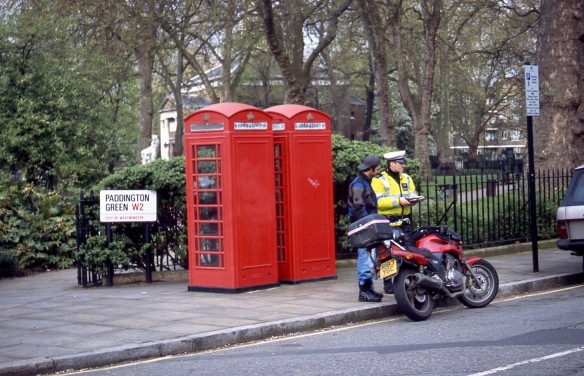CLICK ON IMAGES TO ENLARGE. REPEAT IF REQUIRED.
Today was rainy enough to warrant another trip back to the Streets of London colour slides from May 2005.
Hadrian Mews, N7 is a gated street in Holloway, off Islington’s Roman Way. It probably pays to be security conscious here.
Epping Place and Granary Square, N1 are off Liverpool Road. The Lighterman bar at 3, Granary Square has mixed reviews.
Sheldon Square, W2, in the Paddington Basin development has featured a couple of times before. By May 2005 it was a popular venue for walkers, both real and artificial. The gentleman in the right foreground is destined to stride towards another out of shot, forever sporting his short-sleeved shirt, whatever the weather.
Over at Paddington Green, Sarah Siddons dominates the scene.
Two years ago her nose had not looked as complete as this.
It is to be hoped that, from the relaxed attitude of this motorcyclist that the policeman was helping him with directions. Mrs Siddons can be seen to our left of the Telephone Boxes.
The Britannica website has this entry on her:
‘Sarah Siddons, née Kemble (born July 5, 1755, Brecon, Brecknockshire, Wales—died June 8, 1831, London, Eng.), one of the greatest English tragic actresses.
She was the eldest of 12 children of Roger and Sarah Kemble, who led a troupe of traveling actors (and were progenitors of a noted family of actors to a third generation, including a famous granddaughter, Fanny Kemble). Through the special care of her mother in sending her to the schools in the towns where the company played, Sarah received a remarkably good education, even though she was accustomed to making appearances on the stage while still a child. While still in her teens, she became infatuated with William Siddons, a handsome but somewhat insipid actor in her father’s company; such an attachment, though, had the disapproval of her parents, who wished her to accept the offer of a squire. Sarah was sent to work as a lady’s maid at Guy’s Cliff in Warwickshire. There she recited the poetry of Shakespeare, Milton, and Nicholas Rowe in the servants’ hall and occasionally before aristocratic company, and there also she began to exhibit a talent for sculpture (which was subsequently developed, especially between 1789 and 1790, and of which she later provided samples in busts of herself). The necessary consent to her marriage to Siddons was at last obtained, and the marriage took place in Trinity Church, Coventry, in November 1773.
-
 Sarah Siddons.© Photos.com/Thinkstock
Sarah Siddons.© Photos.com/Thinkstock
The new Mrs. Siddons, aged 18, then joined a new acting company. It was while playing at Cheltenham in 1774 that she met with the earliest recognition of her powers as an actress, when by her portrayal of Belvidera in Thomas Otway’s Venice Preserv’d she won the appreciation of a party of “people of quality” who had come to scoff. When the theatrical producer David Garrick was told of her acting prowess, he sent a representative to see her. At the time, she was playing Rosalind in As You Like It in a barn in Worcestershire. Garrick offered her an engagement, but when she appeared with him at Drury Lane, London, in 1775, she was a failure. She then went back on tour in the country, where she earned a reputation as the queen of tragedy on the English stage.
In 1782, at the request of Richard Brinsley Sheridan, who had succeeded Garrick, she consented reluctantly to appear again at Drury Lane as Isabella in Thomas Southerne’s Fatal Marriage. This time her success was phenomenal. From then on she reigned as queen at Drury Lane until, in 1803, she and her brother John Philip Kemble went to Covent Garden. In 1783 she was appointed to teach elocution to the royal children. She retired from the regular stage on June 29, 1812, with a farewell performance as Lady Macbeth in Macbeth. On this occasion the audience would not allow the play to proceed beyond the sleepwalking scene, which Siddons was said to have performed to perfection.
Gainsborough Flowers of 43 Marylebone High Street offer same day delivery to anywhere in Australia for orders placed before 4.00 p.m.
The gentleman using his mobile phone in this shot of Ashland Place, W1 is walking past a small public park in which I sometimes sat, although I never tried the Rajdoot
in Paddington Street, which has many excellent reviews.
In 1961 the old Marylebone Police Court moved from Seymour Place into a former swimming baths at 181 Marylebone Road. Marylebone Magistrates Court was closed and transferred to City of Westminster Magistrates Court in March 2007. (https://search.lma.gov.uk/scripts/mwimain.dll/144/LMA_OPAC/web_detail/REFD+PS~2FMAR?SESSIONSEARCH)
We in the UK will never agree on the meaning of ‘ne’er cast a clout until May is out. Clout is an archaic word for an article of clothing. May is both the fifth month and the May or hawthorn tree which blooms in that month. The controversy focusses on whether the aphorism refers to the blossom being out or the month being over. The two people here leaving Lisson Grove appear to be hedging their bets. The tree is in blossom, but the month was not over.
Late this afternoon we drove to Lymington postal sorting office to collect a letter that required a signature. When I eventually name and shame the culprits in the remortgage fiasco, this will be explained.
This evening we dined on Jackie’s marvellous beef and mushroom collage; toothsome carrots, Brussels sprouts, runner beans, and new potatoes. The Culinary Queen drank Hoegaarden and I drank more of the cabernet sauvignon.
P.S. See Becky’s comment below for important additional information on the mural. I should have remembered this was the old Woolworth’s head office because that is where George Onley, my club cricket captain from the 1950s and ’60s once worked.













